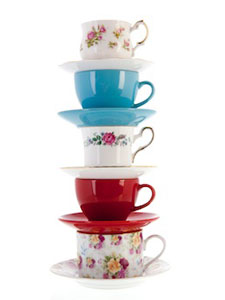Spring Cleaning: Sort Through the Tea Cupboard

Spring cleaning isn't just for ridding yourself of never-worn clothes or book overload or all the objects we collect, wear out, tire of. It's also the time to look through the tea cupboard to prepare it for new selections from the vital spring season of newly-plucked fresh teas.
Teas stored properly can last a long time, but alas, they do not last forever. If a container of tea doesn't smell fresh, if the leaves are dull and without "life" or if the leaves have crumbled to dust, it's time to recycle them into your garden, as a mulch around plants or into the compost pile or toss them into the garbage. You deserve a great cup of tea each and every time you drink but if that tin got relegated to the back of the shelf and was forgotten, say goodbye.
What if you're not sure? Try a cup. If the flavor is fine and the fragrance lovely, it's a keeper, but drink it up soon.
How are you storing your teas? They should be kept in a cool, dark place, NOT next to the stove and NOT along a sunny window and NOT in the refrigerator. Jars with tight-fitting lids; tea tins; porcelain or crockery containers with tight-fitting lids or, if they come that way, keep them in the vacuum sealed bags you purchased them in. The key to keeping teas fresh is to avoid light, moisture and air. Even if a bargain price tempts you, buy in small quantities and drink promptly. The best buy is a tea that you enjoy within several months.
Are cups and mugs in good condition? Do you really want to drink from a cup or serve from a pot that's chipped or cracked? Don't let sentiment guide you. If you simply cannot toss a cracked pot that Auntie Em gave you, then turn it into a planter. You'll still be able to look at it and think of your favorite auntie but you won't risk burning yourself from a leaky pot or, worse, scratching your lips from a chipped cup.
Scoops and strainers last a long time, but as strong as they are, sometimes the scoops get bent or, if wooden, they get splinters, so toss the ones that do not work anymore. Buy a new tea sock or new tea strainer. Your teas will brew easier and you will have that enormous satisfaction that comes from a cleanly-brewed cup of tea.
What about your tea kettle? Whether a stovetop or an electric kettle, if you haven't dedicated only spring water to it, or used a filter to purify your tap water, it, it's likely to amass a white powder coating from the minerals in your tap water. It's fairly harmless, mainly a mixture of calcium and magnesium from mineral deposits found in tap water, but decidedly unattractive and, dare we say it? Can impact the flavor of your tea. Clean water begets a clean cup of tea, so descale (clean) that kettle of unsightly lime scale. Here's how:
Lemon Juice: The Natural De-scaler
Citric acid, vinegar and lemon juice have the right amount of acidic quality to cut through the scale, however, lemon juice is certainly the cleanest, most natural product to use. For thin layers of scale, cut a lemon in quarters and rub the lemon, pulp side down, over the area. Use a never-used scouring pad if stains remain. Rinse thoroughly.
For stubborn or older scale residue, cut up two small lemons, squeeze out the juice and add both the juice and the spent lemons into the kettle. Pour water into it to cover the lemons and boil. You can also just let it sit overnight. The scale will be gone.
Alternative Idea: Vinegar
If you prefer to use vinegar, choose white vinegar and pour in equal amounts of vinegar and water, bring it to a boil, turn off the heat and allow the kettle to sit a few hours, or overnight. Repeat as necessary.
To avoid heavy duty scaling, clean your kettle at the first signs of any scaling. An even easier method is simply to pour 1/2 cup of white vinegar into the kettle and allow to sit overnight. This vinegar-alone method is very effective.
After Care
To avoid any residue of lemon or vinegar, boil spring water in the kettle several times and discard. Prepare a cup of tea and taste; if you smell or taste any vinegar or lemon, rinse several more times with boiling water.
If odors linger, mix 1/4 cup of baking soda with enough water to fill the kettle three-fourths to the cup. Allow to soak for 10-15 minutes, stir in the kettle and rinse until all residue of the baking powder is gone.
If cleaning an electric tea kettle, remember to avoid submerging it in water.
To keep your tea kettle clean of ugly scale buildup, always use spring or purified water. Use our fantastic graviTEA water filter. Its powerful charcoal filters flush away mineral buildup providing you with clear, clean fresh water each and every cup.
Now you're ready to savor delicious tastes of the latest harvests. Here are a few ideas to try: Direct from Fujian, this Golden Spring tea will delight all the sense. This golden curled budge of this black will delight the eyes and its spring-sweet taste will please the palate.
White Eternal Spring combines the delicate leaf buds of white tea with a mélange of sweet natural fruit, fragrant rose petals and hibiscus to remind us that spring is the rebirth of all the bounty of the season.
